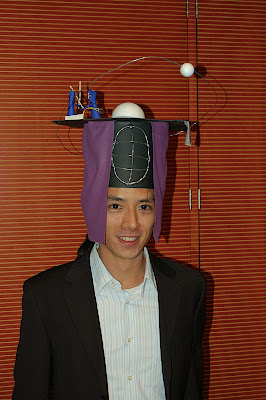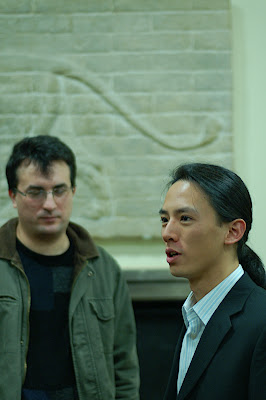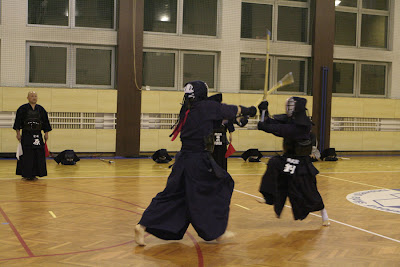.. taste wonderful!! as every time I personally experienced. Friday evening, still fighting with physics equations in Dresden. Saturday morning, threw my pillow over the alarm clock and thereby missed the original train I wanted to get on, but I still managed to arrive at noon. Orientating myself has become much easier now that I have been there for 6-7 times. It's also the second time for the Toru Giga Cup.
As I explained earlier I wasn't participating in the tournament and seminar, which turned out to be a very good idea considering how busy I am at work. Though I wish I could.. This year's event featured Shigeki Yamanaka sensei, 8th Dan Kyoshi, Hiroshi Ozawa Sensei, 7th Dan Kyoshi, and 6 other 7th Dan Senseis. Fortunately, there were jigeikos on both Saturday and Sunday, after the tournament and the examination.
When I arrived the sports hall, the first person I recognised in sight was Thomas Berger. Great to see him again in Czech after last time he came to Dresden with Jindra. Then farther down the hall were Ozawa Sensei and Yamanaka Sensei. Then I saw Aki Suzuki Sensei, 6th Dan, for the first time outside Japan. I still remember how I was astonished by her agility when I fought
with her in Kobukan, and seeing her
practise with Hakamada Sensei in Nittaidai. I used my somewhat improved Japanese to greet her, which from my point of view was a success, but I might have just been ignorant of my own mistakes.
The tournament had already started. The lady's matches were finished. The mens' were on-going. Some memorable moments were the polish team member Jastaks' matches (who placed 2nd), the match between Fritz and Cliek, and Hackl's matches. The large strides of Jastak during seme immediately sent out signals to the spectators that this guy is a seasoned kendoka.
Large strides of the right foot during seme, while keeping the left foot still, requires physical balance as well as the mental confidence. I already saw Martin (Fritz) fighting with Cliek last time in Hradec Kralove. Last time was a tight match, this time, however, Martin looked tired and Cliek was able to score with two fast kote-men's. I met Danny Hackl at the training at Imperial College London
earlier this year. It's funny to see him here again, who is a jolly nice chap. (I'll never forget about the
Champaign joke.) His applied good pressure to his opponents while keeping his kensen in the centre. The built-up tension was subtle and exciting.
Saturday Jigeiko
After the match (with Cliek the first and Jastak placed second) we had free jigeiko (luuucky!) I fought (in order) with Martin, Denisa, Suzuki Sensei, Veronika, and Zawano san. Martin plays an active style of kendo, with lots of kote mens. It would be nice if I was fast enough to do oji-wazas, but I realised later that I mostly struck men and tried to hold my centre the best I could. I have met also Denisa on several occasions and liked her straight kendo. It is nice to fight with such opponent because the essence of kendo is simple and straight in nature. So, no matter one wins or looses he/she would still be on the right track to good kendo.
Fighting with Suzuki Sensei was of course the best of all, in fact, just watching her fight put me complete in awe. Her kendo reminds me of
Yoshimura Sensei, 8th Dan, form Paris, because they have very similar physique, small and yet agile. Their most impressive skill is the footwork. Both before and after the strike, they seem to be floating in air - smooth and fluid movement of the body. Suzuki Sensei attacks very viciously, and in fact, I wouldn't be able to tell that she's a female kendoka in the mid 30's from the way she fights.
Vivian wrote very accurate descriptions of her kendo on her blog. She got me a few debana-mens. I think I didn't give her any pressure at all.. shame..
I was the first to arrive at the party venue by at least half-an-hour. No time was wasted. I immediately ordered a beer and enjoyed it quietly at the bar, before some jolly Austrian participants joined the fun.
Had very pleasant chats with Thomas Berger, Martin and Ozawa Sensei. And I even tried with my limited Japanese to talk to Takano Sensei. Sigh.. where were the words when you need them the most?
Ozawa Sensei told me there is no point to raise the shinai to block. One should attack the center. I told him that when my opponents comes, I can still hold the center, therefore, resulting in tsuki. But even though I want to do Oji-waza, most of the time I'm too slow. He said, no problem, I'm only Shodan, I just need more practice.
Sunday
Morning is the examination from 1st Kyu to 3rd Dan. Afterwards we had an hour of jigeiko. My first one was Ozawa Sensei, and then Takano Sensei.
There were a lot of time spend on waiting. But watching the Senseis doing jigeiko was equally exhilarating. I saw Yamanaka Sensei fighting with Ozawa Sensei and Suzuki Sensei. They fought like young people with continuous strikes often at close distances. However, there was no simple blocking but all blocking were part of oji-waza. I think this is an important thing to remember when doing jigeiko.
My jigeiko with Ozawa Sensei was invaluable. This time I knew what I was doing. He also put more pressure instead of making obvious openings for me. The most memorable was two men-strikes I received from him. One when I wanted to fake a men-strike to make him loose centre and then strike men. What a DUM idea!! As soon as I rose the shinai in front of my face, my men got a solid strike. #$^&#$%&*... The other one was a debana-men, except it was "so debana" that I probably looked like I was sleepy. In fact I wanted to also strike men, but got hit before I did any obvious movement. I wonder how our match look like to the on-lookers.
Fighting with Takano Sensei was easier because I think he was tired and also he played a more quiet kendo. My main objective is to keep a good body balance when doing seme and attack. I think I made a few good strikes.
Then finally when I was just the next to fight with Suzuki Sensei the jigeiko was over.... pity...
All in all...
- This time I saw the fighting spirit and the competitiveness of the Senseis.
- I found that if I keep my body posture straight and a good body balance, I do well and can enjoy anyway regardless of loosing or winning.
- I think my body balance is pretty good now for striking men (gliding forward with my right foot and strike men etc). One thing to improve is the footwork after the strike. I want to do it like Suzuki Sensei, with smooth and fluid movements.
- I need to be more active in applying pressure through the centre.
- I had lots of fun. Thanks to Denisa and Thomas B.!




